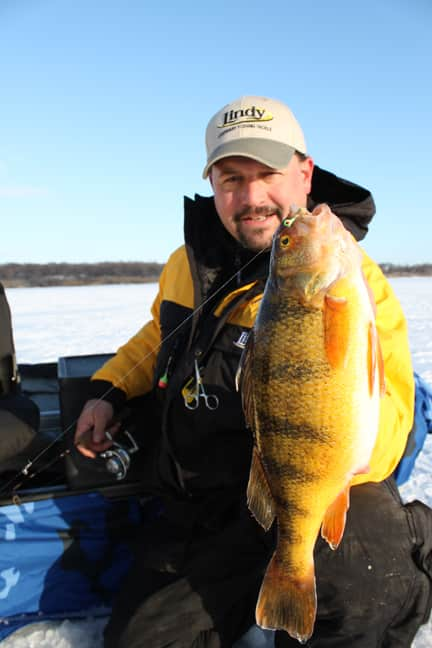Takasaki’s Secrets for Locating Big Ice Panfish
OutdoorHub Contributors 11.21.12

During tournament season, walleye pro Ted Takasaki stays focused on catching walleyes, and he combines that focus with skills and experience to produce consistent success on tour. Once Midwestern lakes freeze, however, Takasaki turns his focus to panfish, and he uses an equally high level of skill and experience to achieve consistent success on the ice.
Whether you’re talking about perch, crappie or bluegills, the key to catching panfish through the ice is finding the fish. More often than not, if you locate schools of panfish and discern what you are seeing on your electronics, you can experiment with jigs and spoons and different types of bait to figure out how to make the fish bite. If you can’t find them, though, you can’t catch them.
For Takasaki, the search process begins during late fall, just before the ice begins forming. If afforded the opportunity, he always scouts in his boat on the lakes where he intends to ice fish. Being so mobile allows him to cover far more water.
He begins by exploring major bays known to hold bluegills, perch or crappie, especially if they have aquatic grass growing, and looks along break lines both with his eyes and with his graph. He’s not necessarily looking for fish (although making mental notes about where they fish are most concentrated is never a bad thing). Instead, he looks at the weeds themselves because weeds typically produce the best panfish action during the first part of the ice season.
“What I’m looking for are weed edges,” Takasaki said, “and for weeds that are still green late in the year. Along those edges I look for places where the weedline shifts – maybe a little point or a pocket – and I create waypoints for those places, which I put into a handheld GPS that I bring out on the ice with me.”
Lacking the opportunity to visit a lake before the formation of the ice, Takasaki gets the Lakemaster chip for his GPS or finds the best available map and studies the contour lines. He looks for breaklines within bays if it’s early in the season because the weed growth tends to taper along depth breaks. Depending on the lake and the type of vegetation, the weed edge can be quite shallow – only a few feet – or it might be 10 feet deep. On the ice he follows those breaks drilling a lot of holes, and looks for weeds and the same green edges.
Whether or not Takasaki has had the chance to look at the lake before hitting the ice, he always begins by drilling a number of holes, and usually he’ll do a fair amount of looking with his Humminbird Ice 55 before he ever starts fishing. Ideally, he wants to find holes that are just outside of the weed edge so he’s not actually fishing in the weeds but he is close enough that fish using the weeds can ambush his baits. He noted, though, that sometimes you’ll see fish right in the weeds, and if he does he gives those fish a shot.
Once he’s located a promising weed edge, Takasaki drills more holes along that edge and begins to focus on finding fish. Early in the day he does a lot of hole hopping, sometimes just looking with his electronics and fishing other holes briefly to see how many fish are down there and to gauge their mood.
“I usually want to see some fish in a hole before I drop a line,” he said. “A lot of times they will be right on the bottom, but sometimes they’ll be a little off the bottom or even halfway up. Perch tend to be right on the bottom at that time. Crappies and bluegills might be a little off the bottom.”
Catching them
“My favorite jig for panfish is a Lindy Frostee,” he said. “It’s a jig that I can use to really pound the bottom and stir up some sediment to get the fish’s attention. I’ll usually pound it pretty aggressively and then bring it up off the bottom and shake it a little, or maybe just let it sit.”
Takasaki likes the smallest size Frostee Spoon for panfish and normally tips his hooks with one or two waxworms or spikes. If he’s specifically targeting crappie or perch, he starts with a minnow head or entire small minnow hooked through the tail so it fights against the jig.
More often than not, Takasaki never changes from his Frostee Spoon on panfish trips. When he does make a change, it’s usually to a Lindy Ice Worm or a Micro Slick Jig, both of which he fishes the same ways, pounding the bottom initially if the fish are close to the bottom or bringing it up higher for suspended fish.
Takasaki does his panfishing with a light St. Croix Legend ice rod matched with a spinning reel and 2-pound-test Lindy Ice Line.
Changing seasons
Takasaki’s favorite time to ice fish is early in the season (although he never goes out on less than 6 inches of ice). At least for the first few weeks of good ice, he normally finds plenty of panfish along the shallow weedlines and rarely strays out of the bays. As winter progresses, he moves his search onto tapering points at the edges of the same bays, and eventually to deeper flats.
“Later in the year winter, they’ll move from the weeds to the deeper mud flats,” he said, noting that the mud has more aquatic insect larvae in it, and therefore provides panfish with food later in the winter.
While the types of location changes with the season, the basic strategy does not. Any time he’s on the ice fishing for panfish, he’s likely to be drilling bunch of holes, moving frequently with his Humminbird in hand and using a Frostee Spoon to the catch fish.

